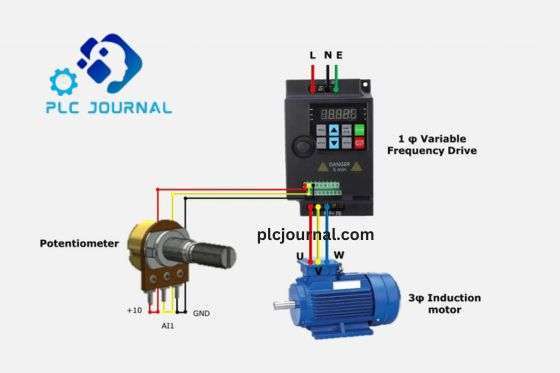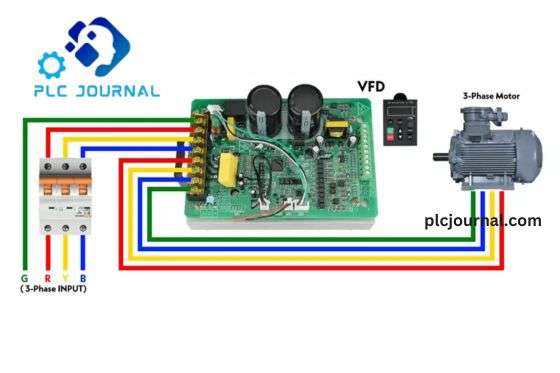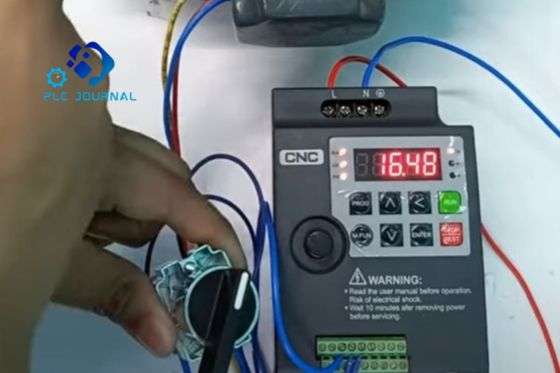What is a Variable Frequency Drive?
A Variable Frequency Drive, commonly referred to as a VFD or AC Drive, is a sophisticated electronic device that is specifically designed to regulate and control the speed, torque, and direction of electric motors. In particular, it accomplishes this by adjusting the frequency and voltage of the electrical power supplied to the motor. Furthermore, the VFD acts as a bridge between the power source and the motor, thereby facilitating precise control and ultimately optimizing motor performance.
Introduction
In today’s world of industrial automation and electric motor control, the Variable Frequency Drive (VFD) has emerged as a pivotal technology; moreover, its ability to revolutionize motor performance, as well as enhance energy efficiency, and additionally offer precise control over speed and torque, therefore, makes it a critical component in various industries.
This comprehensive article first explores the fundamentals of VFDs; next, it examines the different types available and their compatibility with motors. Furthermore, it discusses operation principles and the benefits of VFDs, as well as their applications in power conversion. In addition, distinctions from related terms like AC drives and variable speed drives are clarified, followed by troubleshooting guidance, and finally, the article concludes with a summary of the key takeaways.
Types of VFD
VFDs come in various types, each specifically designed to cater to particular motor characteristics and application requirements; moreover, the primary types include the following:
- Scalar Control VFD: These VFDs adjust the frequency and voltage supplied to the motor while ignoring motor current. They are suitable for simple applications whereas precise control of motor speed is not critical; therefore, they offer a cost-effective solution, and additionally, require minimal setup and maintenance.
- Vector Control VFD: Also known as Field-Oriented Control (FOC) VFDs, these devices provide advanced control by considering both motor current and voltage. They are ideal for applications demanding high precision and dynamic control.
- Sensorless Vector VFD: These VFDs offer vector control without the need for additional sensors for motor feedback; consequently, they are a cost-effective choice for applications whereas sensor installation is impractical, and additionally, they simplify system design and maintenance.
CAN A VFD BE INSTALLED ON ANY MOTOR?

While VFDs are versatile and compatible with many types of motors, not all motors are suitable for VFD control. Some older or specialized motors may require modifications or replacement to operate effectively with VFDs. The compatibility depends on factors such as motor insulation, winding type, and thermal capacity. Consulting with a qualified engineer or technician is crucial; moreover, it helps determine the suitability of the system and, as a result, identify any necessary adjustments to ensure optimal performance.
HOW DOES A VARIABLE FREQUENCY DRIVE WORK?

The operation of a VFD can be simplified into several key steps. First, understand the system requirements, then configure the drive settings, and subsequently, monitor performance to ensure proper operation.
- Power Input: Initially, the VFD receives alternating current (AC) power from the mains; subsequently, it prepares the power for conversion and processing within the drive system.
- Rectification: Next, it converts the incoming AC power into direct current (DC) through a rectifier circuit; as a result, the power becomes suitable for further processing within the VFD system.
- Inversion: After rectification, the DC power is inverted back to AC power through an inverter circuit; consequently, this AC power has a variable frequency and voltage, thereby enabling precise control of the motor.
- Control Signal: Meanwhile, the VFD’s internal control system determines the frequency and voltage output required; this decision is based on user settings and motor load conditions, and as a result, ensures optimal motor performance.
- Motor Connection: The adjusted AC power is then supplied to the motor, controlling its speed and torque precisely.
By manipulating the frequency and voltage of the output power, VFDs enable motors to operate at varying speeds; moreover, they respond to real-time demands, and consequently, provide energy-efficient performance, thereby optimizing overall system operation.
WHY SHOULD I USE A VFD?
Using a VFD provides a multitude of advantages in industrial and commercial settings:
- Energy Efficiency: The primary benefit of VFDs is energy savings. By matching the motor speed to the required load, VFDs prevent motors from running at full speed when it’s unnecessary. This results in significant reductions in energy consumption and related costs.
- Precise Control: VFDs offer precise control over motor speed and torque, enhancing process efficiency and product quality. They enable soft starts and stops, reducing mechanical wear and stress on equipment.
- Reduced Maintenance: With smoother operation and less wear and tear on motors and machinery, maintenance requirements decrease. Leading to longer equipment lifespan and reduced downtime.
- Improved Process Performance: VFDs allow for dynamic adjustments to meet changing process demands, ensuring consistent product quality and operational reliability.
- Cost Savings: Furthermore, the energy savings and extended equipment life achieved through VFDs translate into substantial cost reductions over time. As a result, businesses benefit from lower operational expenses, and additionally, improved return on investment.
What is the Main Advantage of Using a VFD?
The primary advantage of using a VFD is unquestionably energy savings. By preventing motors from running at full speed when it’s unnecessary. VFDs result in substantial reductions in energy consumption and cost savings, making them a sustainable and economically sound choice.
Can VFDs Be Used for Power Conversion?
Yes, VFDs can serve as power converters. They are versatile devices capable of converting single-phase AC power into three-phase AC power. This capability particularly valuable in scenarios where three-phase power required but not readily available, offering flexibility in power supply.
What’s the Difference Between a VFD, an AC Drive, and a Variable Speed Drive?
In many contexts, the terms VFD, AC Drive, and Variable Speed Drive used interchangeably. As they all refer to the same type of device. These devices control motor speed by varying the frequency and voltage of the power supplied to the motor. However, terminology may vary regionally or among different industries. So it’s essential to understand that these terms generally refer to the same technology.
VFD TROUBLESHOOTING TIPS
Effectively troubleshooting VFD issues requires a systematic approach and adherence to safety precautions. Here are some essential troubleshooting tips:
- Safety First: Always prioritize safety when working with VFDs. Ensure power disconnected and follow safety protocols.
- Check Connections: Examine all electrical connections for loose or damaged wires and tighten them as necessary.
- Monitor Temperature: Overheating can be a common issue. Ensure that the VFD and motor have adequate ventilation and cooling.
- Power Quality: Verify the quality of the incoming power supply. Voltage sags, surges, or harmonics can affect VFD performance.
- Fault Codes: Consult the VFD’s user manual to interpret fault codes or alarms and take appropriate action based on these codes.
- Motor Issues: If the motor behaves abnormally, inspect it for any mechanical or electrical problems.
- Programming: Review and validate the VFD’s programming parameters to ensure they align with the application requirements.
- Consult Documentation: Always refer to the VFD manufacturer’s documentation for specific troubleshooting guidance and recommended solutions.
Conclusion
In conclusion, Variable Frequency Drives (VFDs) are essential components in modern industrial automation and motor control systems. They offer precise control over motor speed and torque, resulting in energy efficiency, improved process performance, and cost savings. Understanding the various types of VFDs, their compatibility with different motors, and the principles of their operation is crucial for maximizing their benefits in various applications.
Additionally, VFDs play a crucial role in power conversion, allowing for flexibility in power supply. While terminology may vary, VFDs, AC drives, and variable speed drives generally refer to the same technology. Finally, when troubleshooting VFD issues, safety should always a top priority, and systematic troubleshooting steps should followed to identify and address problems effectively.
Frequently Asked Questions: What is a Variable Frequency Drive?
Variable Speed or Frequency Drives (VFDs) electronic devices used to control the speed and performance of electric motors by varying the frequency and voltage of the power supplied to them.
VFDs calculate speed by adjusting the frequency of the electrical power supplied to the motor. The relationship between frequency and speed is linear; doubling the frequency typically doubles the motor speed.
VFD motors designed to work with Variable Frequency Drives and can vary their speed as needed. Non-VFD motors operate at a fixed speed and do not have the capability to adjust their speed using a VFD.
VFDs control voltage by converting incoming AC power to DC and then inverting it back to AC with a variable voltage and frequency. The VFD adjusts the output voltage and frequency to control the motor’s speed and torque.
The maximum frequency of a VFD depends on its design and specifications but is typically in the range of 60 to 120 hertz (Hz). Some VFDs may have higher frequency capabilities for specialized applications.
Technical Guides
What Is a Programmable Logic Controller (PLC)? Full Explanation
What is HMI? Human-Machine Interface (HMI)-Full Explanation
What is a Variable Frequency Drive?-It’s complete guidelines
What Is a Servo drive and How Does it Work? It’s complete guidelines
Manual PDF
[PDF] Delta PLC DVP-ES2/EX2/SS2/SA2/SX2/SE&TP Operation Manual Free Download
Delta HMI-DOPSoft User Manual Free Download [PDF]
Cable Making
[DIY-Cable] PLC/HMI-Panasonic Connecting PC
[DIY-Cable] PLC/HMI-Keyence Connecting PC
[DIY-Cable] S7-200 Siemens Connecting PC
[DIY-Cable] Mitsubishi PLC Programming Cable SC-09 for FX-Series
[DIY-Cable] PLC Delta Programming Cable DVPACAB230
[DIY-Cable] PLC OMRON Programing Cable for CJ/CS/CQ-Series
[DIY-Cable] PLC “LS/LG” Programing Cable
[DIY-Cable] PLC “Fatek/Facon” Programing Cable
[DIY-Cable] PLC “Vigor” Programing Cable
[DIY-Cable] HMI “Fuji/Hakko” Programing Cable
[DIY-Cable] “HMI Omron NT-Series” Programing Cable
[DIY-Cable] HMI Keyence “VT3-W4 Series” Cable Connecting To PLC
[PDF] HMI-Weintek Connection PLC Guide






